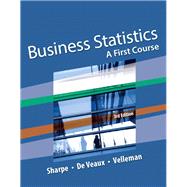NOTE: Before purchasing, check with your instructor to ensure you select the correct ISBN. Several versions of Pearson's MyLab & Mastering products exist for each title, and registrations are not transferable. To register for and use Pearson's MyLab & Mastering products, you may also need a Course ID, which your instructor will provide.
Used books, rentals, and purchases made outside of Pearson
If purchasing or renting from companies other than Pearson, the access codes for Pearson's MyLab & Mastering products may not be included, may be incorrect, or may be previously redeemed. Check with the seller before completing your purchase.
For one-semester courses in business statistics. This text offers a streamlined presentation of Business Statistics, Third Edition, by Sharpe, De Veaux, and Velleman .
This package includes MyStatLab™.
Better Decisions. Better Results.
Business Statistics: A First Course, Third Edition , by Sharpe, De Veaux, and Velleman, narrows the gap between theory and practice—relevant statistical methods empower business students to make effective, data-informed decisions. With their unique blend of teaching, consulting, and entrepreneurial experiences, this dynamic author team brings a modern edge to teaching statistics to business students. Focusing on statistics in the context of real business issues–with an emphasis on analysis and understanding over computation–the text helps students think analytically, prepares them to make better business decisions, and shows them how to effectively communicate results.
0134462726 / 9780134462721 Business Statistics: A First Course Plus NEW MyStatLab with Pearson eText -- Access Card Package
Package consists of:
0134182448 / 9780134182445 Business Statistics: A First Course
032192147X / 9780321921475 MyStatLab for Business Statistics -- Glue-In Access Card
0321929713 / 9780321929716 MyStatLab for Business Statistics Sticker







